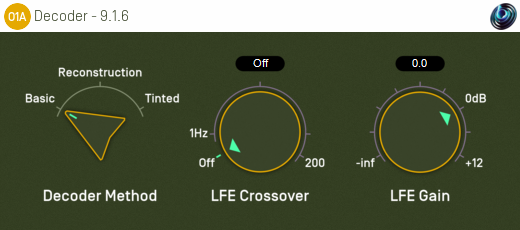O1A Decoder - 9.1.6

Host Support
| Host Type | Support |
|---|---|
| AAX | Yes |
| VST2 | Yes |
Audio
| Channels | Content | |
|---|---|---|
| Input | 4 | O1A |
| Output | 16 | 9.1.6 Surround |
Controls
Description
This plugin takes a first order ambisonics (O1A) mix and decodes it to 9.1.6.
The AAX version of this specific plugin requires Pro Tools 2023.6 or later.
Channels
The channel ordering used is:
| Channel | AAX | VST |
|---|---|---|
| 1 | Front Left | Front Left |
| 2 | Front Centre | Front Right |
| 3 | Front Right | Front Centre |
| 4 | Left Wide | LFE |
| 5 | Right Wide | Left Wide |
| 6 | Left Surround Side | Right Wide |
| 7 | Right Surround Side | Left Surround Side |
| 8 | Left Surround Rear | Right Surround Side |
| 9 | Right Surround Rear | Left Surround Rear |
| 10 | LFE | Right Surround Rear |
| 11 | Left Front Overhead | Left Front Overhead |
| 12 | Right Front Overhead | Right Front Overhead |
| 13 | Left Middle Overhead | Left Middle Overhead |
| 14 | Right Middle Overhead | Right Middle Overhead |
| 15 | Left Rear Overhead | Left Rear Overhead |
| 16 | Right Rear Overhead | Right Rear Overhead |
Spatial Audio Compatibility Warning
Please note that the speaker angles assumed here have front left and right at +/-30 degrees, which match standard use in loudspeaker layouts. However, it appears that binaural Spatial Audio renderers commonly render front left and right bed channels at +/-45 degrees instead, which is close to the "wide" channels and leaves relatively large gaps at the front.
It might be tempting to encode 9.1.6 into a Spatial Audio stream as a 7.1 bed plus eight extra objects for the wide and raised channels, but this discrepancy means that final results are likely to be non-optimal when rendered on headphones rather than on loudspeakers.
This issue was one of the reasons we settled on the dome layout designs used in O3A Spatial Audio and O7A Spatial Audio, which use objects only and typically give better and more consistent results.
The plugin is available in the O1A Decoding plugin library.
Controls
Control: Method
Three methods are supported, "Basic", "Reconstruction" and "Tinted Reconstruction". Generally, "Basic" is recommended except where the speaker rig to be used for playback is known and has been set up accurately.
| Method | Description |
|---|---|
| Basic | This method produces a resilient decoding which should play well on a range of speaker systems including large venues. |
| Reconstruction | This method controls the soundfield at the centre of the listening space to produce a clearer spatial image. It relies on the speaker layout being set up accurately. |
| Tinted Reconstruction | This variant of the Reconstruction method performs HRTF-based tinting on the audio stream to strengthen the spatial image. Again, it relies on the speaker layout being set up accurately. |
Control: LFE Crossover
This determines if any audio is sent to the LFE channel. It may be set to "Off" and this is recommended. If enabled, audio is extracted from the main mix into the LFE channel using the indicated crossover frequency (between 1 and 200Hz).
Control: LFE Gain
If the LFE gain is active, this gain is applied to it. Some export formats may need this set to -10dB to take into account a +10dB gain applied during playback.
- O1A Decoder - 22.2
- O1A Decoder - 3D7.1
- O1A Decoder - 5.1
- O1A Decoder - 7.1
- O1A Decoder - 7.1.2 (Dolby Atmos)
- O1A Decoder - 7.1.4
- O1A Decoder - 9.1.6
- O1A Decoder - Auro-3D 10.1
- O1A Decoder - Auro-3D 11.1
- O1A Decoder - Auro-3D 13.1
- O1A Decoder - Auro-3D 9.1
- O1A Decoder - Cube
- O1A Decoder - Headphones
- O1A Decoder - Hexagon
- O1A Decoder - IMAX 12.0
- O1A Decoder - IMAX 5.0
- O1A Decoder - IMAX 6.0
- O1A Decoder - Mono
- O1A Decoder - Octagon
- O1A Decoder - Quad
- O1A Decoder - Quad Binaural
- O1A Decoder - Stereo
- O1A Decoder - UHJ Stereo
- O1A Injector - FuMa
